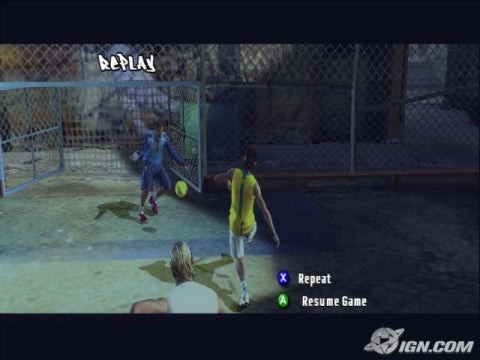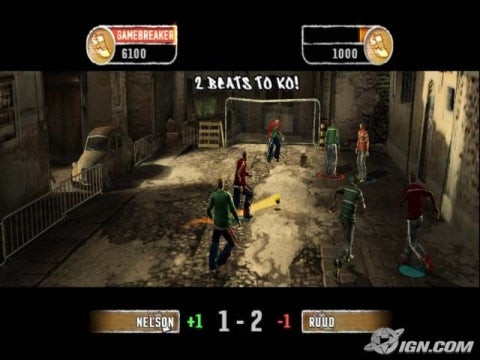After the misstep of the original FIFA Street, anticipation mingled with apprehension for its sequel, Fifa Street 2. Returning to the virtual pitch, there was a clear mission: to discover if EA Sports had truly learned from past mistakes and delivered a worthy successor. The original title left much to be desired, but the promise of refined gameplay and an enhanced trick system offered a glimmer of hope for fans of arcade-style soccer games. Stepping into FIFA Street 2, the immediate impression is one of improvement and a more polished experience.
What sets FIFA Street 2 apart is its obvious commitment to refining the core gameplay. This isn’t a simple reskin of the previous title; it’s a game built with a clearer vision of what makes street soccer engaging. Even the soundtrack signals a change in direction. Gone are the grating, generic tunes, replaced by a selection that actually complements the on-screen action. The inclusion of DJs like Zane Lowe, who prioritize music over disruptive commentary, is a welcome change, creating a much more immersive atmosphere. Moving through the game’s various modes, it becomes evident that FIFA Street 2 is a more structurally sound and less buggy experience than its predecessor. The range of tricks has been expanded and integrated more effectively into the gameplay, blurring the lines between pure soccer mechanics and over-the-top athleticism. This sequel successfully carves out its identity by offering diverse gameplay styles that cater to both soccer enthusiasts and fans of elaborate trick-based sports.
 Ronaldinho in action in FIFA Street 2, showcasing enhanced player animations and trick system
Ronaldinho in action in FIFA Street 2, showcasing enhanced player animations and trick system
At its core, FIFA Street 2 remains true to the arcade spirit of the “EA Street” brand. It’s a game where flair and trickery take precedence over traditional soccer tactics. Purists seeking a realistic simulation might find it jarring, but for those who embrace the spectacle of street soccer and enjoy over-the-top skills, FIFA Street 2 hits a sweet spot. While traditional soccer fundamentals might take a backseat, the game offers a unique brand of fun. To fully appreciate FIFA Street 2, it requires a shift in mindset, leaving behind the expectations of games like Winning Eleven and embracing the arcade nature of street football. This sequel confidently doubles down on what made the first game distinct but refines the execution to create a more enjoyable and less frustrating experience.
FIFA Street 2 expands upon the foundation laid by the original, offering a suite of modes designed to cater to different play styles. The familiar “Play Now” mode allows for quick matches, while the “Creation Zone” offers customization options for players and teams. The career mode, dubbed “Rule the Street,” is the heart of the single-player experience, alongside the skill-focused “Skills Challenge” mode, ideal for honing trick skills and competing for bragging rights. Within “Game Modes,” players can select “Friendly” matches, delve into the career progression of “Rule the Street,” or test their dexterity in “Skills Challenge.” EA Sports has clearly focused on addressing the shortcomings of the original, particularly in “Rule the Street,” which now features a greater variety of match types. Beyond simply scoring goals, objectives now include accumulating skill points, executing “pannas,” winning with Game Breakers, and other rule variations. This injection of variety significantly alleviates the repetitive nature that plagued the first FIFA Street.
One notable advancement in FIFA Street 2 is the option to play matches with a more traditional soccer ruleset. This inclusion initially seems paradoxical within an arcade-focused title, but it reveals an interesting dimension to the game. Playing “regular old soccer” in FIFA Street 2 highlights both its surprising functionality and its inherent limitations in that format. While functional, the basic soccer gameplay feels somewhat underwhelming compared to the over-the-top trickery that defines the core experience. It inadvertently reinforces the game’s strength: its dedication to flamboyant skills and unrealistic maneuvers. After experiencing both modes, the trick-centric gameplay undeniably emerges as the more engaging and unique aspect of FIFA Street 2. This realization underscores that FIFA Street 2 isn’t trying to be a traditional soccer simulator; it’s a celebration of street soccer culture, emphasizing style and showmanship over strict realism.
Embracing this arcade spirit is key to unlocking the enjoyment in FIFA Street 2. Once the focus shifts to mastering tricks and combos, the game reveals its depth. The juggling mechanics are significantly improved, offering greater control and fluidity. Players can seamlessly transition between juggling the ball with their feet, knees, shoulders, and head, incorporating these moves directly into gameplay to outmaneuver opponents. Certain game modes even eliminate the need to score goals entirely, focusing purely on accumulating trick points. This pure trick-based gameplay, while a departure from traditional soccer, presents its own unique challenge and satisfaction, aligning perfectly with the game’s design philosophy. While the long-term appeal might lean towards shorter bursts of play, typical of arcade experiences, the core loop of mastering tricks and outplaying opponents remains consistently engaging within that context.
The “Trick Stick” is central to the enhanced gameplay of FIFA Street 2. Utilizing the analog sticks in conjunction with triggers and shoulder buttons, players can execute a wide array of tricks to deceive defenders. The juggle system adds a vertical dimension to the gameplay, building upon the aerial elements introduced in the first game. The revamped trick system rewards players for chaining together juggles and continuous tricks with teammates, leading to impressive combos. These combos are particularly potent in trick-focused game modes, especially when utilizing the refined juggling mechanics. Mastering defensive counters becomes crucial, as opponents adept at trickery can quickly dominate matches. Scoring goals is intentionally made more challenging than in the original FIFA Street, further emphasizing the importance of skillful trickery to create scoring opportunities. Effective attacking play involves passing, initiating combos, and strategically positioning teammates for scoring chances, while the AI defense is programmed to be more disciplined and challenging. However, the close-quarters nature of street soccer, with eight players often clustered around the goal area, can sometimes lead to visual clutter and make it difficult to track the action from certain camera angles.
 Aggressive defending is a key aspect of street soccer in FIFA Street 2
Aggressive defending is a key aspect of street soccer in FIFA Street 2
While the Trick Stick system adds depth, it also introduces a notable design flaw. Defensive players can become momentarily helpless when an offensive player successfully executes a trick. If a defender misjudges a trick, a “juke animation” is triggered, freezing the defender’s movement for a short period. This animation lock can be frustrating, especially considering the confined playing areas. Attempting to maintain distance from attacking players to avoid these animations is often ineffective due to the juke animation’s surprisingly wide radius. However, FIFA Street 2 attempts to address this imbalance by providing defensive players with their own Trick Stick moves to counter offensive maneuvers. By correctly anticipating and executing a counter-trick, defenders can regain control and disrupt the attacker’s flow.
Despite these attempts at balance, core gameplay issues persist. Firstly, the animation locks, while intended to create dramatic moments, can feel restrictive and remove player agency, even when attempting to evade an opponent. Secondly, the defensive mechanics beyond countering tricks are less refined, often resorting to basic button-mashing actions like sliding tackles and shoulder barges. This creates a dichotomy between the skillful finesse of the trick system and the somewhat crude nature of the defensive play. The absence of referees in street soccer is thematically appropriate, but it also means that overly aggressive and even violent defensive tactics go unchecked, occasionally detracting from the overall flow of the game. Finally, the potential for endless trick loops is a significant concern. A skilled player can trap a defender in a continuous sequence of tricks, locking them into an animation loop that is difficult to escape. This not only diminishes the fun but also introduces an element of unfairness into matches.
In conclusion, FIFA Street 2 represents a significant step forward from its predecessor. It refines the core gameplay, introduces a more engaging trick system, and offers a variety of game modes to keep players entertained. While it retains the arcade-style focus that might alienate purist soccer fans, it successfully carves out its niche as a fun and accessible street soccer experience. Despite some lingering issues with animation locks and defensive balance, FIFA Street 2 delivers an improved and more polished take on trick-based soccer. For fans of arcade sports titles and those seeking a less serious, more flamboyant alternative to traditional soccer games, FIFA Street 2 is a worthy contender and a testament to the potential of street soccer in video games.
